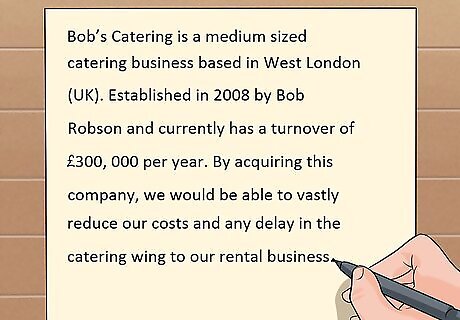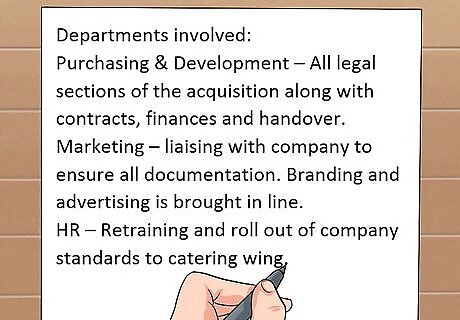
views
X
Research source
If you are a company looking to acquire another company, you will need to understand how acquisitions work and how to find quality target company candidates. Pretty early in the acquisition process, you will be asked to write and submit an acquisition proposal to the target company. An acquisition proposal is a formal offer to purchase another company. Within your proposal you will identify the companies involved, describe the transaction, and attach related business documents.
Finding Acquisition Candidates

Pursue logical extensions of your existing business. Before you can propose to acquire another company, you need to find suitable candidates. By following certain rules for finding suitable acquisition candidates, you can be assured that, whether the acquisition is successful or not, you have a plan in place that will minimize mistakes. When you first start looking for companies to acquire, always look in adjacent spaces that provide logical extensions to the business plan you already have. Do not try to expand into other markets too quickly. When you make acquisitions within your own niche, you take advantage of the strengths you already have. For example, if you have a strong toy manufacturing team, use that manufacturing expertise to acquire other toy companies. Do not work to acquire a distribution company. In addition, when you acquire other companies in adjacent markets, you can keep your brand consistent. Your company must be trusted in the marketplace in order to succeed. If you acquire a company in another field, your brand will be unknown in that field and it may be tough to be trusted. When you look for companies to acquire, ask yourself whether you can add more value to that company than any other acquirer can. If the answer is yes, that company might be a good acquisition candidate.

Consider making multiple small acquisitions. Instead of making one big acquisition, try making multiple smaller acquisitions. By making multiple small acquisitions, you are protecting yourself against failure. By diversifying your acquisitions, you ensure that one failure will not bury your company. Think about acquisitions as a portfolio of investments. When you diversify your investments, you produce more predictable financial results over time. If you invest in one stock, if that stock plummets, you lose your entire investment. However, if you invest in multiple stocks, bonds, and mutual funds, the success or failure of one will not affect the success or failure of the others. When you look for companies to acquire, try to find companies that represent 5% or less of the entire market you hold. For example, if you have a company that holds $5,000,000 of a specific market, look for companies that hold $250,000 or less of that same market.

Set up an acquisition team. Never let one or more existing staff departments handle acquisitions. Instead, create a separate department focused solely on acquisitions. Acquisitions are a lot of work and you do not want to take away from any one employee's normal employment function so they can focus on an acquisition. For example, your executive team focuses daily on managing the existing business and maximizing shareholder value. If you task them with completing acquisitions, you will take time away from their existing duties, which will ultimately hurt the existing business. Instead, create a team of experts that can gauge strategic and cultural fits, identify business similarities, and establish a road map for a successful acquisition. This team should check in with you regularly to report their progress.

Create clear criteria. When your acquisition team reports to you, what information are you looking for? While each acquisition is different, it is important to have clear criteria laid out for your team. In general, there are two types of acquisitions. The first type of acquisition is the bolt-on, which is an acquisition that fits neatly into your already existing business or market. The second type of acquisition is the platform, which takes your business into a new (although adjacent) market. Each of these acquisitions will need to be judged using different criteria. With bolt-on acquisitions, your focus needs to be on probable business similarities and how they will show up in revenues and expenses. You should look for companies that can help you cross-sell products and services. Look for opportunities to combine facilities and staff within your existing infrastructure. Look for complimentary technology that can increase your competitive advantage while saving you money. Your financial expectations with this type of acquisition should be more short-term with modest returns within three years. With platform acquisitions, immediate revenue opportunities and cost-savings are less important. Instead, more strategic questions should be asked. For example, is this a business you want to be in? Do you understand the market? Do you have brand recognition? Is the acquisition company culturally compatible with your company? While financial screening is necessary with platform acquisitions, it is not as important as the more strategic questions.

Utilize acquisitions properly. Never attempt to acquire a company if you are desperate. When you are desperate you tend to purchase more than necessary and you tend to pay a higher price. Instead, look at your desperation objectively and determine alternatives to acquisition. For example, if your business is performing poorly, do not try to reverse the trend by purchasing another. Instead, diagnose your problem areas and fix them from within. You should always expand from your strengths, not from your weaknesses.
Drafting the Acquisition Proposal

Start with an introduction. Your proposal's introduction should introduce the companies involved and describe the factual situation surrounding the proposed acquisition. If your proposal has been discussed with the target company beforehand, your proposal's introduction might reiterate the agreements that have already been reached between you and the target company. If your proposal is for internal purposes only, or if the target company has not been involved up to this point, your introduction might only include your version of the facts, including your willingness to acquire the other company. If this is a formal proposal with the ability to bind both parties, this section could be written like a contract and contain whereas sentences that describe the transaction. If this is more of an informal proposal, regular paragraphs might suffice.

Define important terms. Somewhere towards the beginning of your proposal should be a list of important terms and their definitions. Acquisition proposals can be complex documents with a lot of industry terms not known to some people. A definitions section will help ensure that the target company and others within your company understand the proposal. Common terms you might need to define include acquisition proposal, company shareholders, deferred compensation plan, disclosure schedule, hedging agreement, intellectual property, bylaws, and shares. The more formal and complex your proposal is, the more terms you will usually have to define.

Identify the companies involved. Your proposal should have an in-depth description of each company involved with the possible acquisition. You should have two sections, each one describing one of the companies. When you describe the target company, make sure you include their name, registered office, their capital (i.e. how much cash they have and whether it is in the form of stock), their board of directors', and how their stock ownership is divided (i.e., who owns how much stock in the company). Your company should also be described and should include your name and office, the reason you believe your company fits well with the target company, your capital, your board of directors', and how your stock ownership is divided.

Describe the acquisition. The bulk of your proposal will describe, in great detail, how the acquisition will work. You will need to explain not only what the acquisition will look like but also what effect the acquisition will have on both your company and the target company. When you describe the acquisition, you should state that your company will purchase the target company and, while the target company will retain its name and structure, will be under your control. You also need to cite to any laws and regulations you must follow in order to complete the transaction in a legal manner. You need to identify how the target company's bylaws and articles of incorporation are going to be changed to reflect the acquisition. You will also need to describe what will happen to the employees, directors, and board members of the target company once it is acquired. One of the most important provisions in this section will be how stocks in the target company will be handled. Will you leave them as is and allow shareholders to keep their shares? Will you offer a cash purchase of stock? Will you issue new stock? All of these issues must be touched on in your proposal. The proposal needs to be detailed so it provides enough information to help the target company and your company make an informed decision about the acquisition.

Make valuation calculations. Your proposal must also include the financial background of both companies and a description of how the acquisition will be paid for. For example, if you plan on purchasing a target company, you might describe their assets, liabilities, and their net equity. You will then identify the proposed purchase price. The proposed purchase price needs to broken down in detail to describe how it was figured and how it will be funded. For example, you might choose to fund the purchase with debt (i.e., loans) and equity (i.e., cash for ownership interests). Look at examples and templates of proposals to get a good idea of how this section needs to be set up.

Draft termination provisions. While you always want the deal to go through, you need to contemplate how the acquisition can be responsibly terminated before it happens. This section should describe an allowable time table for termination, after which penalties should be assessed if the deal is abandoned. You need to describe the manner in which termination should occur. For example, you might allow for mutual written consent by either or both parties, automatic termination if some government entity does not allow the acquisition, termination by shareholders, or if one party materially breaches the proposal.

Insert boilerplate. Boilerplate is a term for general contract provisions that don't describe the content of the agreement but instead describe how the agreement will be read by a court. These provisions only need to be included if your proposal is meant to be a binding contract. If your proposal is internal only or meant to be a soft offer, you might not need to include these provisions. If you are including boilerplate, consider including the following: Severability clause Amendment clause Entire agreement clause Governing law clause Headings clause Waiver clause

Include additional agreements. An acquisition is not simply completed once both parties agree to the terms of a proposal. You also need to consider making other agreements that will help move the acquisition forward and complete the deal. Depending on where you are in the process, your acquisition proposal might include additional agreements that will help finalize the acquisition. If so, attach these agreements to the end of your proposal. Examples of additional agreements include: Confidentiality and access to information agreements Employee benefits agreements Sample resignation letters Sample public announcements Sample required notices Directors' and officers' indemnification and insurance

Include space for signatures. If your proposal is meant to be a binding contract, you will need to provide a signatures page where both you and the target company can sign. If your proposal is purely internal or for informational purposes only, you will not need to provide this space.
Understanding Acquisitions

Consider common reasons for acquisitions. Acquisitions generally take place for one of five common reasons. If you are looking at acquiring another company, see if your reason for acquisition matches one of these. If it does, consider moving forward. If it does not, rethink your need or ability to acquire the company. The first possible reason you could acquire a company is to improve the target company's financial performance. If you acquire a company and improve their financial performance, your overall financial performance improves as well. You generally accomplish this by purchasing a company and radically reducing their costs in order to improve the margins and cash flow. The second possible reason for acquiring a company is to consolidate and remove any excess capacity in your industry. When you acquire a competitor, you can utilize their infrastructure and therefore increase your ability to produce goods and services. At the same time, when you acquire a company, you are knocking out a competitor. The third possible reason for acquiring a company is to accelerate market access for the target company's product. Often, a small company has an innovative product but they do not have the ability reaching the entire market. If you have that market reach, you might acquire the smaller company in order to get that company's product to more people. The fourth possible reason for acquiring a company is to get skills or technologies faster or at a lower cost than they can be built. For example, a company might have existing superior intellectual property that would take you decades to produce on your own. Instead of spending the money and time producing that technology, you simply buy it. The fifth possible reason for acquiring a company is to find new companies with great growth potential. If you can acquire a company early, before it grows significantly, you can pay a smaller price for that company and reap the benefits of its growth down the road.

Start with an offer. Acquisitions usually start with an offer. This usually begins with your company discreetly buying up shares in the company you wish to acquire. However, the law only allows you to purchase 5% of the company's shares before you must make a filing with the Securities Exchange Commission (SEC). In that filing, you will be required to disclose how many shares you own and whether you are planning on buying the company. At this point, or maybe after some preliminary negotiations, you will submit an acquisition proposal to the company you want to acquire.

Wait for a response. After your acquisition proposal has been sent to the company you wish to acquire, that company will need to respond. In general, the target company can accept your proposal, attempt to negotiate, execute some sort of takeover defense, or find another company to make the acquisition. If the target company accepts your acquisition proposal, then you can go ahead and consummate the deal. If you and the target company negotiate, it will most likely be over the purchase price, possible job retention agreements, or compensation packages. If the target company does not want to be acquired, they can initiate proceedings to attempt to stop you. These proceedings are usually called poison pill schemes or hostile takeover defenses. In general, the target company will allow all of their shareholders (except you as the acquiring company) to purchase additional shares in the company at a dramatically reduced rate. This will dilute your shares and will make it more difficult for you to purchase a majority. If the target company doesn't mind being bought but doesn't want to be bought by you, they may look for a white knight company to come in and offer a comparable purchase price.

Close the deal. Once your acquisition proposal is accepted, the deal will need to be completed with some transaction. Acquisitions can be completed in various ways and each one has its benefits and drawbacks. In a cash-for-stock transaction, the target company's shareholders will receive cash in exchange for their shares in the company. For you, the acquirer, the shares can be bought and you can push possible hostile shareholders out. However, these deals often require a large amount of cash, which you may not have available. Also, for the shareholders, the sale of their stocks is taxable, which is not always ideal for the shareholders. In a stock-for-stock transaction, there is a simple exchange of share certificates. The shareholders exchange their certificates from the target company for new share certificates in the new company. For you, the acquirer, this can be advantageous if the existing shareholders were open to the acquisition and if you do not have enough cash on hand to pay for existing shares. For the shareholders, this can be advantageous because the exchange will not be taxed. You can also choose to do some combination of the two transactions.















Comments
0 comment